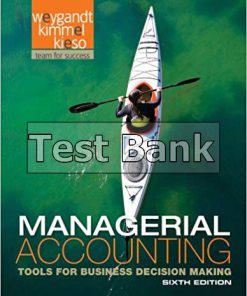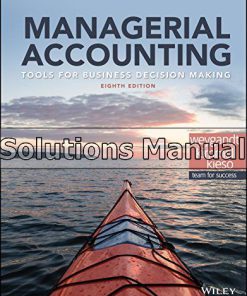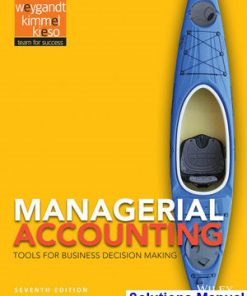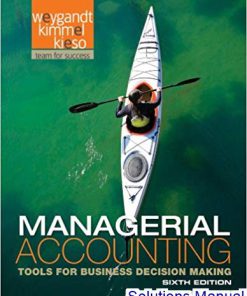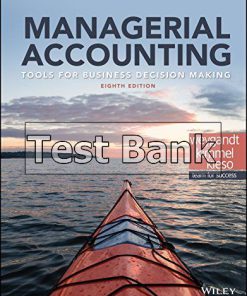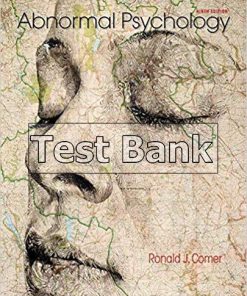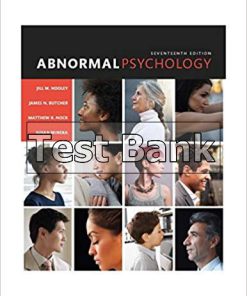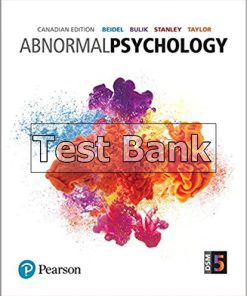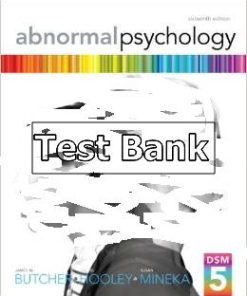Managerial Accounting Tools for Business Decision Making Canadian 4th Edition Weygandt Test Bank
$26.50$50.00 (-47%)
Managerial Accounting Tools for Business Decision Making Canadian 4th Edition Weygandt Test Bank.
You may also like
Managerial Accounting Tools for Business Decision Making Canadian 4th Edition Weygandt Test Bank
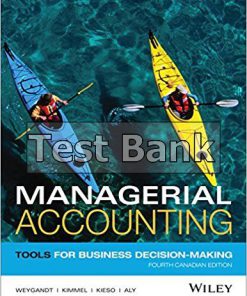
Product Details:
- ISBN-10 : 1118856996
- ISBN-13 : 978-1118856994
- Author:
Weygandt’s Managerial Accounting 4th Canadian Edition is written by a highly trusted and respected author team – Weygandt, Kieso, Kimmel and Aly. Hundreds of thousands of students have been successful using books written by these authors. Again, these authors bring you a one semester, undergraduate text that presents the fundamental concepts of managerial accounting in a concise and easy-to-read fashion.
This edition retains the same features that made it popular in the previous editions: it gives students all the necessary techniques and concepts of managerial accounting in a focused, concise framework with an excellent pedagogy that’s been praised by instructors. It does this by focusing on the tools students need to succeed. Because not all students taking this course may be accounting majors, the authors have focused more on building decision making skills; on how to use accounting information to make quality business decision; and on the tools needed by future managers.
Pair this book with our new Managerial Accounting Cases by Carty and Wick for a complete solution for your Managerial Accounting needs.
Table of Content:
- Chapter 1 Managerial Accounting
- Accounting Keeps Businesses Afloat
- Managerial Accounting Basics
- Comparing Managerial and Financial Accounting
- Management Functions and Organizational Structures
- Organizational Structures
- Business Ethics
- Creating Proper Incentives
- Code of Ethical Standards
- Corporate Social Responsibility
- Managerial Accounting Today
- Service Industry Trends
- Managerial Accounting Practices
- Accounting Organizations and Professional Accounting Careers in Canada
- Chapter 2 Managerial Cost Concepts and Cost Behaviour Analysis
- Mining Cost-Cutting Potential
- Managerial Cost Concepts
- Manufacturing Costs
- Prime Costs and Conversion Costs
- Product versus Period Costs
- Cost Concepts—A Review
- Cost Behaviour Analysis
- Variable Costs
- Fixed Costs
- Relevant Range
- Mixed Costs
- Classifying Costs
- Manufacturing Costs in Financial Statements
- Income Statement
- Balance Sheet
- Chapter 3 Job-Order Cost Accounting
- A Pressing Need to Calculate Costs
- Cost Accounting Systems
- Job-Order Cost Systems
- Process Cost Systems
- Job-Order Cost Flow
- Accumulating Manufacturing Costs
- Assigning Manufacturing Costs to Work in Process
- Raw Materials Costs
- Factory Labour Costs
- Manufacturing Overhead Costs
- Predetermined Overhead Rate
- Accounting for Jobs Completed and Sold
- Assigning Costs to Finished Goods
- Assigning Costs to Cost of Goods Sold
- Job-Order Costing for Service Companies
- Summary of Job-Order Cost Flows
- Advantages and Disadvantages of Job-Order Costing
- Reporting Job Cost Data
- Under-Applied or Over-Applied Manufacturing Overhead
- Chapter 4 Process Cost Accounting
- Business in a Bottle
- The Nature of Process Cost Systems
- Process Costing for Service Companies
- Similarities and Differences Between Job-Order Cost and Process Cost Systems
- Operations Costing
- The Flow and Assignment of Manufacturing Costs
- Assignment of Manufacturing Costs—Journal Entries
- Equivalent Units
- Weighted-Average Method
- Refinements on the Weighted-Average Method
- The Production Cost Report
- Calculate the Physical Unit Flow (Step 1)
- Calculate the Equivalent Units of Production (Step 2)
- Calculate the Unit Production Costs (Step 3)
- Prepare a Cost Reconciliation Schedule (Step 4)
- Preparing the Production Cost Report
- Calculate Equivalent Units and Create a Production Cost Report for a Sequential Process Setting
- Equivalent Units Under FIFO
- Illustration
- Comprehensive Example
- FIFO and Weighted Average
- Chapter 5 Activity-Based Costing
- The “ABCs” of Tracking Costs
- Traditional Costing and Activity-Based Costing
- The Need for a New Approach
- Activity-Based Costing
- Applying an Activity-Based Costing System
- Identify and Classify Activities and Allocate Overhead to Cost Pools (Step 1)
- Identify Cost Drivers (Step 2)
- Calculate Overhead Rates (Step 3)
- Assign Overhead Costs to Products (Step 4)
- Unit Cost Comparison
- Benefits and Limitations of Activity-Based Costing
- Benefits of ABC
- Limitations of ABC
- Activity-Based Costing in Service Industries
- Traditional Costing Example
- Activity-Based Costing Example
- Chapter 6 Decision-Making: Cost–Volume–Profit
- Not Much Room to Move on Price
- Cost–Volume–Profit Analysis, Income Statement, and the Contribution Margin
- Basic Components
- Cost–Volume–Profit Income Statement
- Contribution Margin per Unit
- Contribution Margin Ratio
- Break-Even Analysis
- Mathematical Equation
- Contribution Margin Technique
- Graphic Presentation
- Target Operating Income and the Margin of Safety
- Target Operating Income Before Tax
- Target Operating Income After Tax
- Margin of Safety
- CVP and Changes in the Business Environment
- Sales Mix
- Break-Even Sales in Units
- Break-Even Sales in Dollars
- Effect on Contribution Margin Ratio
- Effect on Break-Even Point
- Effect on Margin of Safety Ratio
- Operating Leverage
- Chapter 7 Incremental Analysis
- Outsourcing Can Be Outstanding
- Decision-Making and the Incremental Analysis Approach
- Incremental Analysis Approach
- Types of Incremental Analysis
- Accept an Order at a Special Price
- Make or Buy
- Sell or Process Further
- Retain or Replace Equipment
- Eliminate an Unprofitable Segment
- Allocate Limited Resources
- Chapter 8 Alternative Inventory Costing Methods: A Decision-Making Perspective
- No Fishy Business in Tracking Costs
- Inventory Costing Methods
- Illustration Comparing Absorption Costing and Variable Costing
- Net Income Effects
- Decision-Making Concerns
- Performance Evaluation
- Potential Advantages of Variable Costing
- Normal Costing
- Throughput Costing
- Chapter 9 Pricing
- A Clear Pricing Strategy
- Pricing Goods for External Sales
- Target Costing
- Total Cost-Plus Pricing
- Absorption Cost-Plus Pricing
- Variable Cost-Plus Pricing
- Pricing Services
- Transfer Pricing for Internal Sales
- Transfer Pricing—An Explanation
- Transfer Pricing Approaches
- Transfers Between Divisions in Different Countries
- Chapter 10 Budgetary Planning
- Budgeting for Smooth Skies
- Budgeting Basics and the Master Budget
- Budgets and Accounting
- The Benefits of Budgeting
- Essentials of Effective Budgeting
- Length of the Budget Period
- The Budgeting Process
- Budgeting and Human Behaviour
- Budgeting and Long-Range Planning
- The Master Budget
- Preparing the Sales, Production, and Direct Materials Budgets
- Sales Budget
- Production Budget
- Direct Materials Budget
- Preparing the Direct Labour, Manufacturing Overhead, and S&A Expense Budgets
- Manufacturing Overhead Budget
- Selling and Administrative Expenses Budget
- Budgeted Income Statement
- Preparing the Financial Budgets
- Cash Budget
- Budgeted Balance Sheet
- Budgeting in Non-Manufacturing Companies
- Merchandisers
- Service Enterprises
- Not-for-Profit Organizations
- Chapter 11 Budgetary Control and Responsibility Accounting
- Keeping the Budget on Track
- The Concept of Budgetary Control and Static Budget Reports
- Budgetary Control
- Static Budget Reports
- Flexible Budgets
- Why Flexible Budgets?
- Developing the Flexible Budget
- Flexible Budget—A Case Study
- Flexible Budget Reports
- Responsibility Accounting for Cost and Profit Centres
- The Responsibility Accounting Concept
- Controllable versus Noncontrollable Revenues and Costs
- Responsibility Reporting System
- Principles of Performance Evaluation
- Accounting for Various Responsibility Centres
- Evaluating Performance in Investment Centres
- Return on Investment (ROI)
- Responsibility Report
- Judgemental Factors in ROI
- Improving ROI
- Residual Income Compared with ROI
- Residual Income Weakness
- Chapter 12 Standard Costs and Balanced Scorecard
- An Academic Scorecard
- Standards—Needs and Costs
- Distinguishing Between Standards and Budgets
- Setting Standard Costs
- Analyzing and Reporting Variances from Standards
- Direct Materials Variances
- Causes of Materials Variances
- Direct Labour and Manufacturing Overhead Variances
- Direct Labour Variances
- Manufacturing Overhead Variances
- Variance Reports and the Balanced Scorecard
- Reporting Variances
- Statement Presentation of Variances
- Balanced Scorecard
- Journal Entries
- Ledger Accounts
- Chapter 13 Planning for Capital Investments
- Planning Big Projects Takes Energy
- The Capital Budgeting Evaluation Process and the Cash Payback Technique
- Cash Flow Information
- Illustrative Data
- Cash Payback Technique
- Net Present Value Method
- Equal Annual Cash Flows
- Unequal Annual Cash Flows
- Choosing a Discount Rate
- Simplifying Assumptions
- Comprehensive Example
- Capital Budgeting Challenges
- Intangible Benefits
- Profitability Index for Mutually Exclusive Projects
- Risk Analysis
- Post-Audit of Investment Projects
- Internal Rate of Return Method
- Determining the Internal Rate of Return
- Internal Rate of Return vs. Net Present Value
- Annual Rate of Return Method
- Annual Rate of Return Method: Pros and Cons
- Index
- Company Index
- Subject Index
- EULA
People Also Search:
managerial accounting tools for business decision making canadian
managerial accounting tools for business decision making canadian 4th edition
managerial accounting tools for business decision making canadian weygandt
managerial accounting tools for business decision making canadian solution manual download pdf
managerial accounting tools for business decision making canadian download scribd


